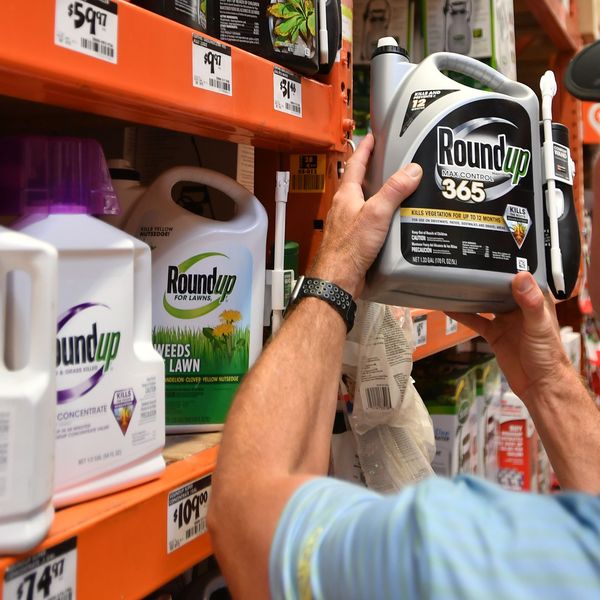New Study Confirms One of Agent Orange's Toxic Legacies
Aircraft used to dump pernicious mix on Vietnam continued its threat for years.
A new study reveals that members of the Air Force Reserve were exposed to significant levels of Agent Orange long after planes were dumping the toxic cocktail on Vietnam.
The findings, published online Friday in the journal Environmental Research, stand in contrast to claims by the U.S. Air Force and the VA.
The researchers found that from 1971-1982, Air Force Reservists who flew C-123 aircraft which had been used to spray Agent Orange and continued to be used for other operations were exposed to levels of dioxin that exceeded U.S standards.
A statement on the VA's website reads:
VA's Office of Public Health thoroughly reviewed all available scientific information regarding the exposure potential. We concluded that the potential of exposure for the post-Vietnam crews that flew or maintained these planes was extremely low and therefore, the risk of long-term health effects is minimal.
Yet these "aircraft occupants would have been exposed to airborne dioxin-contaminated dust as well as come into direct skin contact, and our models show that the level of exposure is likely to have exceeded several available exposure guidelines," stated senior author Jeanne Mager Stellman, PhD, Professor Emerita of Health Policy and Management at Columbia University's Mailman School of Public Health.
The findings could be a game-changer for this group veterans who have been sickened by Agent Orange exposure and have thus far been denied reparations.
"We can't prove it, but everything in here is supportive of the fact that they were exposed and could have been quite highly exposed," Linda Birnbaum, director of the National Institute of Environmental Health Sciences, told The Huffington Post. "In fact, it would be reasonable to assume that those who flew in these planes after the war were more likely to be exposed than those servicemen who had boots on the ground in Vietnam."
__________________________
An Urgent Message From Our Co-Founder
Dear Common Dreams reader, The U.S. is on a fast track to authoritarianism like nothing I've ever seen. Meanwhile, corporate news outlets are utterly capitulating to Trump, twisting their coverage to avoid drawing his ire while lining up to stuff cash in his pockets. That's why I believe that Common Dreams is doing the best and most consequential reporting that we've ever done. Our small but mighty team is a progressive reporting powerhouse, covering the news every day that the corporate media never will. Our mission has always been simple: To inform. To inspire. And to ignite change for the common good. Now here's the key piece that I want all our readers to understand: None of this would be possible without your financial support. That's not just some fundraising cliche. It's the absolute and literal truth. We don't accept corporate advertising and never will. We don't have a paywall because we don't think people should be blocked from critical news based on their ability to pay. Everything we do is funded by the donations of readers like you. Will you donate now to help power the nonprofit, independent reporting of Common Dreams? Thank you for being a vital member of our community. Together, we can keep independent journalism alive when it’s needed most. - Craig Brown, Co-founder |
A new study reveals that members of the Air Force Reserve were exposed to significant levels of Agent Orange long after planes were dumping the toxic cocktail on Vietnam.
The findings, published online Friday in the journal Environmental Research, stand in contrast to claims by the U.S. Air Force and the VA.
The researchers found that from 1971-1982, Air Force Reservists who flew C-123 aircraft which had been used to spray Agent Orange and continued to be used for other operations were exposed to levels of dioxin that exceeded U.S standards.
A statement on the VA's website reads:
VA's Office of Public Health thoroughly reviewed all available scientific information regarding the exposure potential. We concluded that the potential of exposure for the post-Vietnam crews that flew or maintained these planes was extremely low and therefore, the risk of long-term health effects is minimal.
Yet these "aircraft occupants would have been exposed to airborne dioxin-contaminated dust as well as come into direct skin contact, and our models show that the level of exposure is likely to have exceeded several available exposure guidelines," stated senior author Jeanne Mager Stellman, PhD, Professor Emerita of Health Policy and Management at Columbia University's Mailman School of Public Health.
The findings could be a game-changer for this group veterans who have been sickened by Agent Orange exposure and have thus far been denied reparations.
"We can't prove it, but everything in here is supportive of the fact that they were exposed and could have been quite highly exposed," Linda Birnbaum, director of the National Institute of Environmental Health Sciences, told The Huffington Post. "In fact, it would be reasonable to assume that those who flew in these planes after the war were more likely to be exposed than those servicemen who had boots on the ground in Vietnam."
__________________________
A new study reveals that members of the Air Force Reserve were exposed to significant levels of Agent Orange long after planes were dumping the toxic cocktail on Vietnam.
The findings, published online Friday in the journal Environmental Research, stand in contrast to claims by the U.S. Air Force and the VA.
The researchers found that from 1971-1982, Air Force Reservists who flew C-123 aircraft which had been used to spray Agent Orange and continued to be used for other operations were exposed to levels of dioxin that exceeded U.S standards.
A statement on the VA's website reads:
VA's Office of Public Health thoroughly reviewed all available scientific information regarding the exposure potential. We concluded that the potential of exposure for the post-Vietnam crews that flew or maintained these planes was extremely low and therefore, the risk of long-term health effects is minimal.
Yet these "aircraft occupants would have been exposed to airborne dioxin-contaminated dust as well as come into direct skin contact, and our models show that the level of exposure is likely to have exceeded several available exposure guidelines," stated senior author Jeanne Mager Stellman, PhD, Professor Emerita of Health Policy and Management at Columbia University's Mailman School of Public Health.
The findings could be a game-changer for this group veterans who have been sickened by Agent Orange exposure and have thus far been denied reparations.
"We can't prove it, but everything in here is supportive of the fact that they were exposed and could have been quite highly exposed," Linda Birnbaum, director of the National Institute of Environmental Health Sciences, told The Huffington Post. "In fact, it would be reasonable to assume that those who flew in these planes after the war were more likely to be exposed than those servicemen who had boots on the ground in Vietnam."
__________________________

